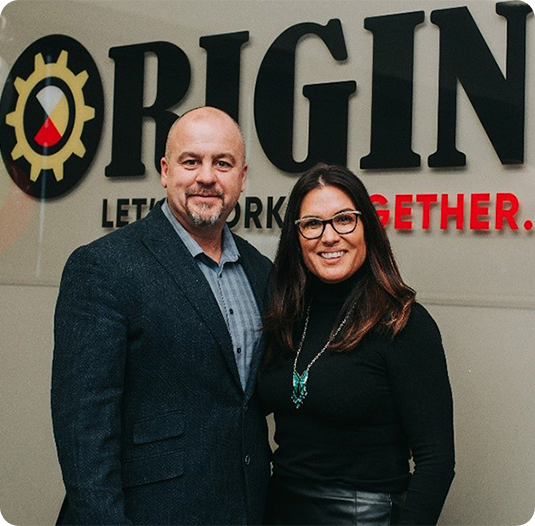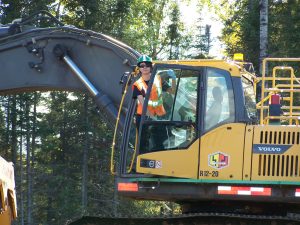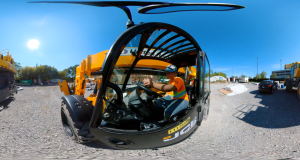Announcements
For press opportunities, please email info@immersivelink.ca.

Women in Skilled Trades: How to Connect, Inspire and Uplift
Over the past few decades, we have seen a movement away from stereotypical roles for men and women in the workforce. That being said, skilled trades have always been and continue to be a heavily male-dominated field. While women have shown interest in pursuing these careers, they are aware of the many challenges that they could face. Right from the hiring process, women have experienced discrimination. Hiring teams may believe sexist stereotypes or see women as having physical limitations that prevent them from performing at the same level as their male employees. If women make it to the worksite, they often find themselves having to work harder to prove themselves and gain respect from their coworkers. For a number of reasons, they may also find themselves on the receiving end of a different types of harassment. While organizations are aware of these issues and have taken steps forward to improve workplace safety and diversity, its important to continue to highlight and promote women in the trades and ensure they have the support they need.
Earlier this year, the Government of Canada released a statement that focused on the promotion in-demand skilled trades as a first-choice career path. Now more than ever, as Canada recovers from the COVID-19 pandemic, skilled tradespeople are in high demand to fill well-paying jobs and build rewarding careers. The most recent projections estimate about 700,000 skilled trades workers are expected to retire between 2019 and 2028, creating an ever-growing need to recruit and train thousands more and this will need to include women if we are going to meet this demand.
Connecting women to opportunities for work readiness
An important, and simple way, to support the increase of women in the skilled trades is promoting opportunities to increase their job readiness. An opportunity could be anything from a training course or workshop to an apprenticeship or job opportunity. This promotion can come from trades unions, educational institutions, organizations and so on. Women who find interest in these careers may not think this is something they can pursue and may not know where to start. By having this promotion, you can be reaching people who may need to see these opportunities to get their start. Having a diverse workforce encourages different opinions, work styles, and leadership styles that can lead to innovation and an overall happier and more productive team.

One of the Operation Innovation Training working with heavy equipment!
During the development of experiences for our ImmersiveLink Careers library, we have had the opportunity to meet with and hear from women who pursued careers as a carpenter, machinist, horticultural technician, and more. Seeing increased representation in the skilled trades allows for younger generations of women to start to see opportunities for themselves in these careers. Two of the hosts we have worked with, LiUNA and Aecon, have partnered on their Women in Trades program. They offer fully paid training in a women’s only cohort and then connect them to field placements. Getting to work and train alongside other women, allows the participants to gain confidence in themselves, increase their readiness for this career path, and help each other work through some of the shared struggles they are facing.
Times are changing
“I’ll always remember my aunt out there working alongside the men. It made me so proud…my how have times changed!”
I remember as a child, when my aunt Marilyn would come home from working on the road on pavement construction near the Biinjitiwaabik Zaaging Anishinaabek community, most widely known at that time as Rocky Bay. She came home dirty and tired but always had a smile on her face. I remember talking to her about her job and always recounting her saying, “it was her most favourite job ever!” I had only seen men working in construction so knowing that my aunt was able to complete her duties and came home every day with the feeling of accomplishment meant a lot to me and I’m sure her children too. Nowadays, we see women as a constant in these positions, more than ever! I’ll always remember my aunt out there working alongside the men. It made me so proud…my how have times changed!
Mentorship and community can inspire change
Although my career has not taken me down the trades path, I can understand the frustrations that women in trades can feel. Being in a male-dominated space can be intimidating and requires courage and determination. There are so many portals these days that are put in place for women and specifically Indigenous women who want to make a difference and change the narrative. I’m considered a ‘senior” Aunty within our LIFT Collective Community on Facebook, where Indigenous Women who either own a business or are working towards the launch of their business, connect virtually and share daily on programming and funding sources available for all of us to share, support and motivate one another. I was most recently a member of The Elleiance Network, which is a cohort of female entrepreneur, trail blazers within the city of Thunder Bay. Another hurdle for women in the workforce is advancing to leadership roles, specifically being voted onto Boards. But that is another story…stay tuned!
“Being in a male-dominated space can be intimidating and requires courage and determination.”
I see so much importance in having these spaces where women can meet and share their experiences. Hearing from others that they have shared experiences and even advice to offer in these situations can help you feel less isolated and also help you navigate your time at work. Recently we held our Women in Trades Day at the ORIGIN office in partnership with Mattawa Education. We had a variety of speakers come and talk about their careers in the trades or career opportunities and supporting programs. It was so cool to see a room full of women excited about the trades and have powerful speakers in a position where they could inspire a younger audience.
Creating gender-safe spaces

Robyn, a carpenter’s apprentice, working out on the construction site.
Majority of our workshops are co-ed but we see the value of creating spaces and opportunities specifically for women in the trades. Our Women Under Construction workshop offers a women-focused environment for those who are interested in exploring construction related roles. Participants have the chance to get an introduction to heavy equipment with our simulators and complete a personality assessment to better understand where their strengths lie.
Uplifting women to increase retention
While there has been in an increase in programs, training opportunities, scholarships, and more there is still a lot of room for growth. According to Statistics Canada, in 2022, the Trades occupation is represented by 92.6% men and 7.4% women[1]– the lowest proportion of women in any occupation in Canada! Another important aspect to consider is the retention of women who enter these fields. Retention efforts can come in many forms including benefits, flexible environment for caretakers, and cultivating a supportive work environment.

Sasha, a machinist at Linamar, in her ImmersiveLink Careers experience.
To identify ways to maintain and improve retention, its necessary to first look at the root causes of women leaving these positions. Consider the types of policies and procedures your organization has in place to promote a safe work environment. Ensure that these policies are inclusive and address the needs of women in the workplace. If your team is unsure of what this can look like, ask your employees! They will be able to give you firsthand insights into what their experience is like on the ground. This will also allow you to determine if these activities are effective. For example, you can run a diversity training session with your team but if what is shared isn’t enforced or there is still resistance from employees, you will continue to face similar issues.
Importance of workplace culture and employee satisfaction
Another thing to consider is to look at the culture within your organization to determine if you are creating the right environment for the necessary behaviours to overcome these challenges. I think we can relate to the consumption of the “koolaid” at all levels of an organization. We see this being accomplished through culture change within an organization, for example in a variety of sectors where safety is more than a policy it is in fact a culture. Creating a culture that understands the value of having women participating and contributing in skilled trades will in turn enable us to meet the expected labour demand.
If your team is looking for ways to recruit and train more women for your team, you can find our contact form here.
Let’s work. Together.
